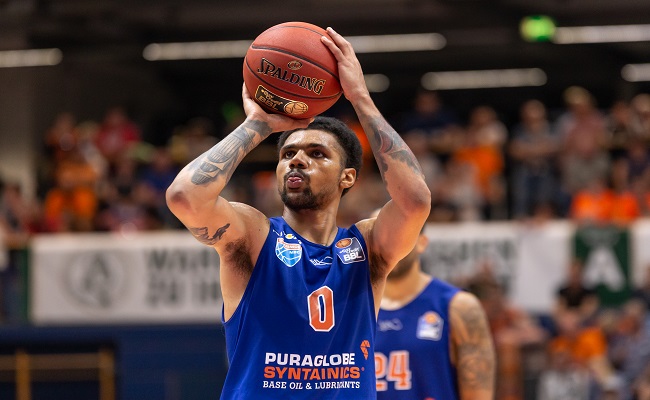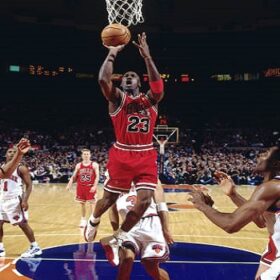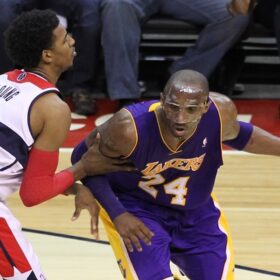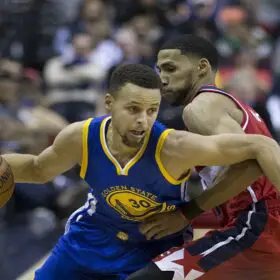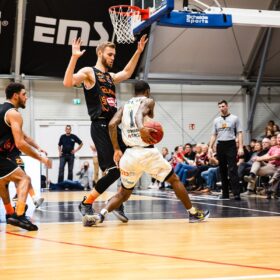In basketball, there are times where you shoot brick shots that can result in an airball. Yes, every basketball player has a bad day, and it is inevitable. However, every basketball player shouldn’t focus on the bad game they’ve had. Instead, basketball players should focus on the next game.
There are many rules in the NBA regarding air ball, and it has often been misinterpreted by basketball players, especially the new ones. One of these rules is rebounding an air ball shot. What is rebounding an airball shot?
When a basketball player shoots a ball and it turns into an air ball, he/she will rebound their air ball shot. The question of most basketball players about this is that is it legal?
Can you rebound your air ball in basketball? In NBA basketball, rebounding your air ball is not legal, and it can result in a traveling violation. However, in some basketball leagues like high school basketball, NCAA, and FIBA, players may rebound their air ball as long as it is a shot attempt.
It depends on the league, and the league officials whether rebounding your air ball is illegal. In a pickup basketball game, it is illegal for a basketball player to rebound their air ball. If you are playing street basketball, this violation may cause many arguments.
However, there are more things you need to know about this rule. We have written everything for you young player. All you need to do is to scroll down, and keep reading! Let’s go!
What Is An Air Ball In Basketball?
What is an air ball in basketball? Air ball is a shot a basketball player attempts that misses the basket, rim, net, and backboard entirely. From the word air and ball, which means the ball hits the air only.
Air ball is one of the things that most basketball players and coaches don’t want to happen. Air ball can lose the confidence of one player and can lose the confidence of the whole team, especially if the airball shots happen continuously.
Even though basketball players are adept at shooting, air ball shots are inevitable and should be accepted by every player. Basketball players should accept the reality that there will always be bad games throughout their basketball career.
However, it is not how many bad games you have that matters. What matters most is what you are going to do to prevent that terrible game from happening again. Like the old saying, it is not how much we fail. It is how we stand up and pick ourselves up.
Like I have said above, even though basketball players are adept at shooting, there are still chances that he/she might get an airball shot. There are many reasons why basketball players got air ball shots, and we will discuss them later on.
What Is Considered An Air Ball In Basketball?
Air ball in basketball is any unblocked shot that misses the basket, backboard, net, and rim. It is a shot that doesn’t hit anything except the air. To give you concise information, let me tell you what shot is an air ball in basketball.
What kind of shot is an air ball in basketball? A shot that hits nothing but air is an air ball shot in basketball. From the word air and ball, which means the ball only hit the air. Air ball shots might happen because of many reasons.
Air ball shot will count as a missed field goal. So it means that every air ball is being counted by the statisticians in a basketball game. For example, if a player hits three air ball shots, and makes five shots, the player’s field goal is five out of eight.
What Causes An Air Ball In Basketball?
There are many reasons why air ball shots happen, and it occurs in almost every basketball game. What causes an air ball in basketball? These are the reasons why an airball happens in basketball:
- Have been fouled on a shot
- Fatigues
- Injuries
- Bad shooting warm-up
- Bad shooting form
Have Been Fouled On A Shot
Air ball shots might occur in a basketball game because a player who takes the shot has been fouled while in a shooting motion. When the defensive player makes a contact with the offensive player that is taking a shot, the offensive player might get startled while in shooting motion and might result in an air ball.
However, this is not the worst reason why an air ball might occur because it is usual. The player who attempted the shot that resulted in an air ball, because he/she was fouled, can take back the shot they missed in the free-throw line because they have been fouled while in a shooting motion.
Fatigues
One reason why an air ball shot occurs in basketball is that the player who takes the shot is worn out. NBA players who had jet lag can miss their shots during their game because they experience fatigue caused by jet lag.
I suggest to all basketball players in the world to never play basketball if you have been into the gym or if you have not had enough sleep. Why? Because your body is tired, and it has a large effect on your game. Never go to the gym three to two days before your game, and sleep eight hours at night if you have a basketball game the next day.
Injuries
Injuries are the reason why most basketball players end their careers earlier. Like Kobe Bryant, injuries ended his career because he tore his achilles.
Injuries are another reason why basketball players shoot an air ball. Especially if a player has an injury on their arms, hands, and elbows. Injuries on knees or legs may also affect the shooting accuracy of a basketball player. Because most players get the power to release the ball on their legs.
Bad Shooting Warm-Up
Another reason why air ball shots occur is because of an awful shooting warm-up. If a basketball player enters the game without any warm-up, he/she may have a bad shooting accuracy during the game.
Warm-up is essential before a basketball game. It is like stretching before you hit the dumbbell and do some biceps workout. Without proper warm-up, you can’t play at your highest level. So you should never forget to warm-up!
Bad Shooting Form
Another reason why air ball shots occur in a basketball game is because of poor shooting form.
When we are starting playing basketball, the second thing coaches teach us, after dribbling, is the shooting form. Every basketball player must have a good shooting form. Otherwise, it will be a mess.
Shooting form is much more essential than dribbling. Dribbling is also essential. But don’t focus solely on your dribbling skills. Basic dribbling is ok, as long as you don’t slap the ball when dribbling. Focus more on your shooting form rather than your dribbling because dribbling has no score.
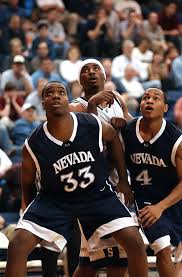
Rebounding Your Own Air Ball Rules In Different Basketball Leagues
If you think that every league has the same rules, then you are wrong. The well-known basketball leagues in the world have different regulations when it comes to rebounding your airball shot.
Let’s take a look at these popular basketball leagues and their rule book to see what they say about a player rebounding its shot that resulted in an air ball.
NBA
The NBA is the most well-known basketball league around the globe. Many die-hard fans out there cheering for their favorite teams. The NBA has its own set of rules. It states that there should be no player rebound their shot if it resulted in an air ball. It will result in a violation and a turnover.
Section XIII—Traveling
f. A player who attempts a field goal may not be the first to touch the ball if it fails to touch the backboard, basket ring, or another player.
In simple words, the NBA does not allow players to attempt to rebound their own shot that did not touch the rim and backboard.
NCAA
While I was searching, I didn’t see any text in the NCAA rulebook that says that a player can’t rebound their air ball shot. Also in high school basketball games. College basketball and high school basketball have the same rules.
Section 6. Traveling
Art. 1. A player shall not travel with the ball.
Art. 2. Traveling occurs when a player holding the ball moves a foot or both feet in any direction in excess of prescribed limits described in this section.
Art. 3. A player who catches the ball with both feet on the playing court may pivot, using either foot. When one foot is lifted, the other is the pivot foot.
Art. 4. A player who catches the ball while moving or ends a dribble may stop and establish a pivot foot as follows:
a. When both feet are off the playing court, and the player lands:
1. Simultaneously on both feet, either may be the pivot foot;
2. On one foot followed by the other, the first foot to touch shall be the pivot foot;
3. On one foot, the player may jump off that foot and simultaneously land on both, in which case neither foot can be the pivot foot.
b. When one foot is on the playing court:
1. That foot shall be the pivot foot when the other foot touches in a step;
2. The player may jump off that foot and simultaneously land on both, in which case neither foot can then be the pivot foot.
Art. 5. After coming to a stop and establishing the pivot foot:
a. The pivot foot may be lifted, but not returned to the playing court, before the ball is released on a pass or try for goal;
b. The pivot foot shall not be lifted before the ball is released to start a dribble.
Art. 6. After coming to a stop when neither foot can be the pivot foot:
a. One or both feet may be lifted, but may not be returned to the playing court before the ball is released on a pass or try for goal;
b. Neither foot shall be lifted, before the ball is released, to start a dribble.
Art. 7. It is traveling when a player falls to the playing court while holding the ball without maintaining a pivot foot.
In simple words, players can rebound their own air ball shot.
FIBA
FIBA also allows a player to rebound or catch their air ball shot. They have the same rules as NCAA basketball.
15.1.2 The act of shooting on a shot:
• Begins when the player starts, in the judgment of a referee, to move the ball upwards towards the opponents’ basket.
• Ends when the ball has left the player’s hand(s), or if an entirely new act of shooting is made and, in case of an airborne shooter, both feet have returned to the floor.
15.1.3 The act of shooting in a continuous movement on drives to the basket or other moving shots:
• Begins when the ball has come to rest in the player’s hand(s), upon completion of a dribble or a catch in the air and the player starts, in the judgment of the referee, the shooting motion preceding the release of the ball for a field goal.
• Ends when the ball has left the player’s hand(s), or if an entirely new act of shooting is made and, in case of an airborne shooter, both feet have returned to the floor.
FIBA allows the player to rebound their own missed shot.
Rebounding Your Own Air Ball In Pick-Up Basketball
This rule alone can cause many arguments and fights when you play pick-up basketball or street basketball. It depends on players playing on how they can talk about what consequences should be given to the player that rebounded its air ball.
Most players that play pick-up basketball games use the rules of the NBA. However, in most cases, players don’t care if one player rebounded its own missed shot that didn’t touch the rim or backboard. Players either play using the rules of the NBA or the rules of NCAA basketball.
Other Related Questions About Air Ball In Basketball
Below are the related questions about rebounding an air ball in basketball.
Does Catching An Air Ball Count As Rebound? Yes! If a player from the other team catches an air ball shot made by their opposing team, intentionally or accidentally, it will be counted as a rebound. Rebounds are credited after any missed shots, including the shots that resulted in an air ball.
Does An Air Ball Count As A Turnover? A shot that resulted in an air ball does not count as a turnover, but it counts as a field goal attempt. It counts as a field goal missed. So if a player made three air balls out of 5 attempts, his/her field goal is 2/5. However, if an airball goes directly at the out of bounds line, it will be a turnover.
What Happens If You Air-Ball A Free Throw? If a free-throw goes air ball, it is considered a dead ball if stepped out of bounds. The free-throw must hit the rim or the board. Free throws that result in an air ball can be rebounded by the opposing team or the teammates of the player attempting the free-throw. But usually, they just let an airball free-throw go out of bounds.
Is It An Air Ball If It Hits The Net? No. If the ball hits the net, it is not considered an air ball. Air ball is any unblocked shot, contested or not contested, that never hit the basket, rim, net, and backboard.
Final Thoughts
Every basketball player must do their best in order not to commit an air ball violation. Basketball players must keep improving their strength and power to release the ball that will reach the rim easily. Focus more on practicing your shooting more than anything else.

